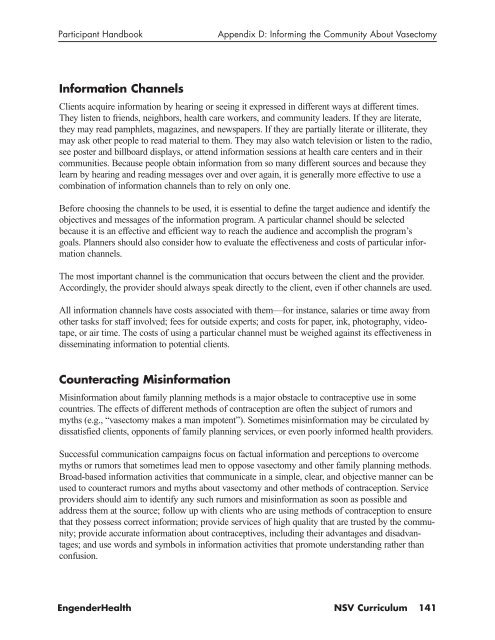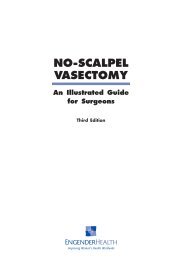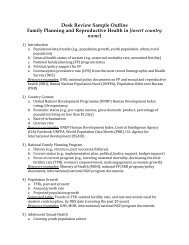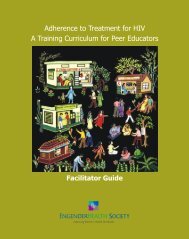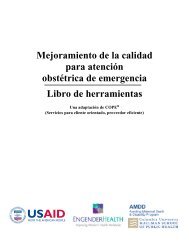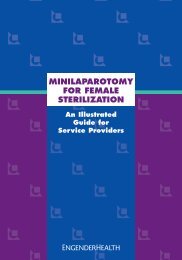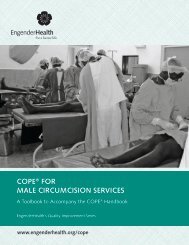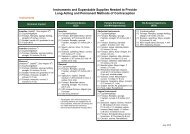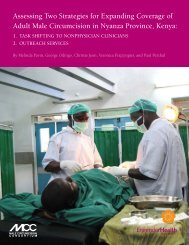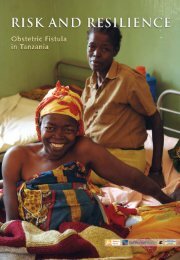NO-SCALPEL VASECTOMY - EngenderHealth
NO-SCALPEL VASECTOMY - EngenderHealth
NO-SCALPEL VASECTOMY - EngenderHealth
You also want an ePaper? Increase the reach of your titles
YUMPU automatically turns print PDFs into web optimized ePapers that Google loves.
Participant Handbook Appendix D: Informing the Community About Vasectomy<br />
Information Channels<br />
Clients acquire information by hearing or seeing it expressed in different ways at different times.<br />
They listen to friends, neighbors, health care workers, and community leaders. If they are literate,<br />
they may read pamphlets, magazines, and newspapers. If they are partially literate or illiterate, they<br />
may ask other people to read material to them. They may also watch television or listen to the radio,<br />
see poster and billboard displays, or attend information sessions at health care centers and in their<br />
communities. Because people obtain information from so many different sources and because they<br />
learn by hearing and reading messages over and over again, it is generally more effective to use a<br />
combination of information channels than to rely on only one.<br />
Before choosing the channels to be used, it is essential to define the target audience and identify the<br />
objectives and messages of the information program. A particular channel should be selected<br />
because it is an effective and efficient way to reach the audience and accomplish the program’s<br />
goals. Planners should also consider how to evaluate the effectiveness and costs of particular information<br />
channels.<br />
The most important channel is the communication that occurs between the client and the provider.<br />
Accordingly, the provider should always speak directly to the client, even if other channels are used.<br />
All information channels have costs associated with them—for instance, salaries or time away from<br />
other tasks for staff involved; fees for outside experts; and costs for paper, ink, photography, videotape,<br />
or air time. The costs of using a particular channel must be weighed against its effectiveness in<br />
disseminating information to potential clients.<br />
Counteracting Misinformation<br />
Misinformation about family planning methods is a major obstacle to contraceptive use in some<br />
countries. The effects of different methods of contraception are often the subject of rumors and<br />
myths (e.g., “vasectomy makes a man impotent”). Sometimes misinformation may be circulated by<br />
dissatisfied clients, opponents of family planning services, or even poorly informed health providers.<br />
Successful communication campaigns focus on factual information and perceptions to overcome<br />
myths or rumors that sometimes lead men to oppose vasectomy and other family planning methods.<br />
Broad-based information activities that communicate in a simple, clear, and objective manner can be<br />
used to counteract rumors and myths about vasectomy and other methods of contraception. Service<br />
providers should aim to identify any such rumors and misinformation as soon as possible and<br />
address them at the source; follow up with clients who are using methods of contraception to ensure<br />
that they possess correct information; provide services of high quality that are trusted by the community;<br />
provide accurate information about contraceptives, including their advantages and disadvantages;<br />
and use words and symbols in information activities that promote understanding rather than<br />
confusion.<br />
<strong>EngenderHealth</strong> NSV Curriculum 141


